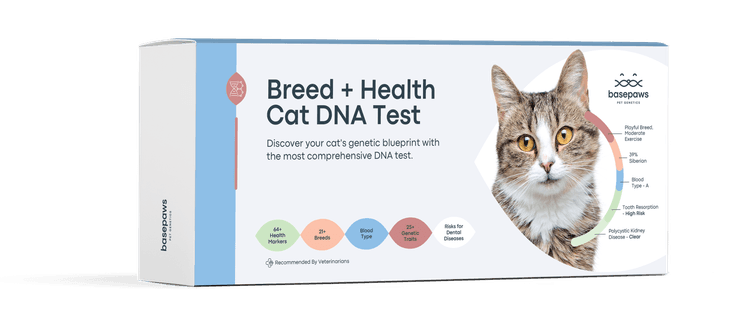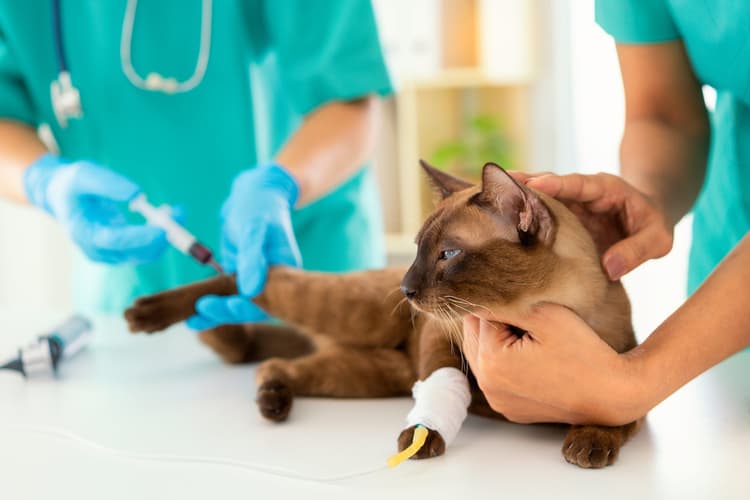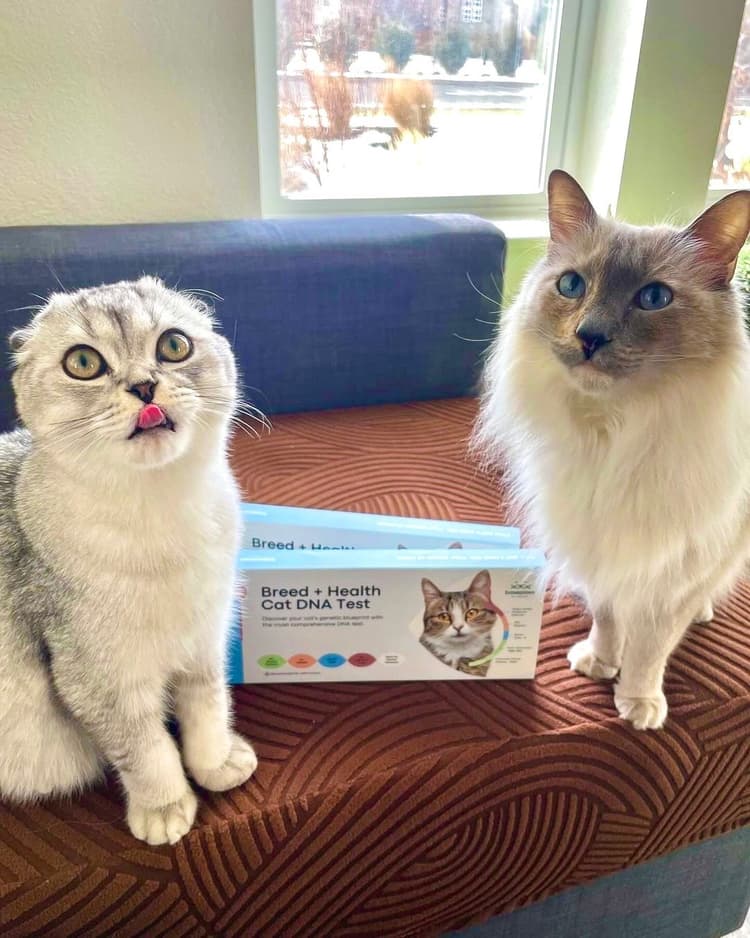As of November 2020, the coronavirus pandemic is here to stay. The SARS-CoV-2 virus has had a devastating impact on public health and the economy. Recent months have also brought the news that pets too can get infected with the virus.
The USDA tracks the number of COVID-19 positive animals in the US and has so far recorded over 30 cat cases and over 20 dog cases. In addition, there is published scientific evidence demonstrating that infected cats have the capacity to spread the virus to other cats. That being said, there is absolutely no evidence of cats (or other pets) ever spreading the disease to humans.
The pandemic has so far been characterized by a severe undersupply of accurate RT-PCR (Real-Time Polymerase Chain Reaction) COVID-19 tests for human use. This has led to under-testing and long result waiting times. Shortage of supplies for human tests is one of the reasons why routine testing of companion animals is not currently recommended by the USDA. There are now high-quality veterinarian-administered RT-PCR COVID-19 tests available specifically for animal use. However, these tests rely on the same reagents used in human COVID-19 RT-PCR tests, meaning that they do little to reduce the pressure on the core reagent supply chain. Earlier this year, there were reported shortages and back-orders of some of those key reagents, such as RNA extraction kits. In addition, from our own internal observations at Basepaws, TaqMan-based RT-PCR reagents (the most commonly used reagents for COVID-19 RT-PCR based testing) saw a significant price increase and buccal/nasopharyngeal swab collection kits designed for RNA preservation were in extremely short supply.
At Basepaws, we are all personally invested in the health and well-being of every cat. Since cats are among the most susceptible animals to COVID-19, we decided to tackle the challenge of developing a versatile PCR-based COVID-19 test with minimal impact on the already strained reagent supply chain for COVID-19 testing. The availability of such a test would be important for improving our understanding of the spread and impact of the SARS-CoV-2 virus on cats. There were three main criteria that we wanted to meet in our test development:
Use a sample collection kit not specifically designed for RNA storage and avoid using commercial RNA isolation kits
Use a PCR method different to the gold standard TaqMan method
Develop and validate a fast and accurate test that can be used for cats and, potentially, other animals
We succeeded in developing a test that is comprised of two different workflows. These can be used together or separately, depending on the available reagents and lab setup. The method can, in principle, be used to test both humans and animals (although more validation is needed for human testing). After discussing our method with the Center for Veterinary Medicine (CVM) at the Food and Drug Administration (FDA), we were invited to participate in an inter-lab comparison study for COVID-19 testing. While participating labs cannot publicly share results from this study, you can read about our internal results, conclusions and experimental rationale below. If you have ever wondered how does one begin to develop a COVID-19 diagnostic test, please read on.
Question 1: Can we avoid using commercial RNA isolation kits and sample collection kits specifically designed for RNA storage?
One of our goals was to avoid dealing with the shortages of swab collection kits designed specifically for RNA preservation. This is why we decided to first test whether the DNA collection swabs we routinely use in our lab for collecting feline DNA (Figure 1) could work for collecting and preserving RNA.

Figure 1. PERFORMAgene PG-100 DNA collection kit (buccal swab) provided by Genotek. Referred throughout this text as ‘the DNA swab’.
This test was important because the SARS-CoV-2 virus has an RNA genome, instead of a DNA-based genome. RNA is typically much less stable in solution compared to DNA. Therefore, our first test compared the results from RNA extraction procedures using our routine DNA collection swab versus a specialized RNA collection swab. We wanted to see whether the preservation solution in the DNA collection swab would work to stabilize RNA. After swabbing our feline test subject, we expected to see a mixture of cat-specific RNA and RNA from different viruses that reside in the cat’s mouth.
Experiment 1 - detecting cat-specific RNAs
We swabbed the mouth of the same healthy cat twice - once with our DNA collection swab and once with the RNA collection swab. With each swab, we tried to get as close to the throat as possible, aiming for an oropharyngeal sample collection, in order to mimic one of the typical ways of collecting a sample for COVID-19 testing. We extracted the RNA using a published method for purifying nucleic acids by solid-phase reversible immobilization (SPRI), which does not rely on a commercial kit. We then compared the results between the two swabs. Gel electrophoresis results suggest that we successfully extracted total RNA from both swabs (Figure 2A). While suitable for qualitative observations, gel electrophoresis is not an appropriate tool to quantify extracted total RNA. To get around this issue, we used two different RNA quantification instruments - Nanodrop and Quantus (Figure 2B). The results from these two instruments were largely in agreement and indicated that we extracted more RNA from the DNA swab than the RNA swab. RNA purity was quantified by absorbance measurements taken at 260/280 nm and 260/230 nm. Ratios of ~2 are generally considered as an indication of good RNA purity (free of residual contaminants from the extraction process). Our data suggest that the RNA extracted from the RNA swab, although lower quantity, is of better quality. However, the best indicator of RNA quality is its functionality in a particular application of interest. In our case, we first wanted to see whether the total RNA we extracted contained measurable messenger RNA (mRNA), not just transfer RNA (tRNA). Cat (and human) cells have thousands of different mRNAs (copies of our DNA that are translated into proteins), varying by tissue type. Viruses, such as SARS-CoV-2, have an mRNA-based genome (they lack DNA). In this experiment, we aimed to detect 2 different ubiquitously expressed cat mRNAs (GAPDH and RSP19) in our RNA extractions from the different swabs (Figure 2C). We first transcribed complementary DNA (cDNA) from our extracted RNA before performing an RT-PCR assay for detection of the 2 mRNAs. The key quantitative result in an RT-PCR experiment is the Cq value, which is the PCR cycle number at which the amplification of the target sequence (in our case - GAPDH or RSP19) rises above background ‘noise’ amplification. In other words, the number of PCR cycles it takes to detect a real signal for your target; the lower the Cq value, the more abundant the target sequence. We performed our experiment in triplicates, using a commercially available cat kidney RNA positive control and a negative no template control (NTC), where the reaction input was water instead of RNA. Usually, NTC samples in an RT-PCR reaction either do not amplify (marked as ‘undetermined’) or amplify around or above the 35th cycle. Our results show that the RNA extracted from both the DNA and the RNA swab contained GAPDH mRNA in similar quantities, while the RSP19 mRNA was more abundant in the RNA from the RNA swab. These results indicate that the quality of RNA extracted from the two swabs is somewhat comparable, with the RNA from the RNA swab potentially having higher abundance of certain RNAs.

Figure 2. RNA extraction from a DNA swab and an RNA swab. (A) Gel electrophoresis comparing the total RNA extracted from a DNA swab vs an RNA swab. The M lane contains a nucleic acid size marker. (B) Measures of RNA amount and purity using NanoDrop and Quantus spectrophotometers. (C) RT-PCR results quantifying the amount of 2 cat housekeeping mRNAs (GAPDH and RSP19) in the RNA extracted from the RNA and the DNA swab collection kits.
Experiment 2 - detecting RNA viruses in the feline oral cavity
After confirming that we can detect feline mRNA with our DNA swab, we next wanted to determine if we can detect viral RNA with our extraction process. We prepared an RNA-seq library from our RNA extraction and sent it for Next Generation Sequencing. Once we got the sequencing data back, we ran the results through a microbial sequence classifier and identified 33 viral genomes, at least 9 of which had RNA genomes (Figure 3). Interestingly, we still detected some viruses with DNA genomes, despite the DNA treatment during library preparation, which aimed to get rid of DNA.

Figure 3. Viral genomes detected in our extracted feline RNA. Viruses with known RNA based genomes are shown in orange.
Answer to Question 1: Our results show that we can use our DNA swab (PERFORMAgene PG-100 DNA collection kit) for collection and extraction of good quality RNA which contains both mammalian and viral RNA sequences. We can also successfully use our internal method for extracting RNA, not relying on commercially available kits.
Question 2: Can we use a PCR based alternative to the gold standard TaqMan RT-PCR method to reliably detect SARS-CoV-2 in a sample?
Most RT-PCR COVID-19 tests use a TaqMan method. This approach relies on two primers specifically binding a target region of interest, in addition to a fluorescently labeled oligo probe binding the region between the two primers (Figure 4A). The fluorescent signal from the probe is only quantified when the DNA polymerase reaches the region bound by the probe during PCR amplification. This mechanism adds extra certainty that the region amplified during the PCR is the exact region we are targeting rather than a non-specifically amplified product. An alternative RT-PCR method - nicknamed SYBR - uses the two target-specific primers, but lacks the oligo probe. It relies on fluorescent signal detection from SYBR Green dye incorporation in any DNA amplified during the reaction. This means that, on average, the SYBR method is more prone to false positive signals if the primers bind to more regions than just the target sequence of interest or form non-specific secondary structures which get amplified. However, if the primer design and molarity are optimized, the SYBR method can be very accurate and reliable (it is also a lot cheaper compared to TaqMan).
We aimed to develop a SARS-CoV-2 detection assay that can be used with either a SYBR RT-PCR protocol or even a conventional, non-fluorescent PCR method, followed by Sanger sequencing for added accuracy (Figure 4B).

Figure 4. A comparison between (A) a conventional RT-PCR detection test for COVID-19 (figure adapted from Esbin et al., 2020) and (B) the PCR based detection assay developed by Basepaws.
The challenge in developing an assay that works with both of these protocols lies in the primer design. RT-PCR typically works most efficiently with primers used for the amplification of short regions - usually 100 - 150 basepairs (bp) long. However, Sanger sequencing works very poorly with such short regions. We tested different primer pairs amplifying larger regions of the SARS-CoV-2 genome in our SYBR RT-PCR assay. After a few failed experiments, we finally identified a primer pair that amplifies 328 bp of the N region in the SARS-CoV-2 genome (perfect size for Sanger sequencing) and works reliably in the SYBR RT-PCR assay.
Since SARS-CoV-2 is just one of many coronaviruses able to infect cats and humans, we had to make sure we are amplifying a signal specific to SARS-CoV-2 and not a different coronavirus. The closest coronavirus to SARS-CoV-2 is SARS-CoV, which caused the 2003 epidemic in Asia and was also shown to be able to infect cats and humans. In addition, many cats are also carriers of the Feline Enteric Coronavirus (FECV), which, in rare cases, causes Feline Infectious Peritonitis. Therefore, it was important that our assay is able to distinguish between SARS-CoV, SARS-CoV-2 and FECV. We compared our target amplification region in the SARS-CoV-2 genome to the corresponding regions in the SARS-CoV and FECV genomes (Figure 5). The FECV sequence is sufficiently different from SARS-CoV-2 to not be considered a threat to our assay’s specificity. The SARS-CoV and SARS-CoV-2 sequences are extremely similar (with the two primer regions covering the same stretches of sequence in the two viruses), meaning that the SYBR RT-PCR part of our assay, when used in isolation, cannot distinguish between the two viruses. However, the Sanger sequencing component of our test can clearly distinguish between the SARS-CoV and SARS-CoV-2 viruses, since it gives us single-nucleotide resolution. When the two viral sequences amplified by our primers are put into The National Center for Biotechnology’s (NCBI) Basic Local Alignment Search Tool (BLAST), the two sequences are correctly and unambiguously identified as either belonging to the SARS-CoV or the SARS-CoV-2 viral genome.

Figure 5. Sequence alignment between SARS-CoV-2, SARS-CoV and FECV in the corresponding region targeted for amplification in the Basepaws assay. (A) shows nucleotide alignment between the 3 viruses, with the primers used in the Basepaws assay shown in color; red shows nucleotides that are the same between all three viruses and green shows nucleotides shared only between SARS-CoV-2 and SARS-CoV. (B) shows protein alignment of the whole 328 bp region targeted for amplification in the Basepaws assay; color code is the same as in (A).
We tested our primers using a conventional PCR protocol (Figure 6A, 6B) and a SYBR RT-PCR protocol (Figure 6C). We used the 2019-nCoV_N_Positive control #10006625 commercially available plasmid as our positive control. This positive control contains the complete nucleocapsid (N) gene from SARS-CoV-2 and we used it to spike-in our cDNA reactions prior to PCR or RT-PCR amplification with our primers. Using a gel electrophoresis assay, Figure 6A shows a clear and specific amplification signal of the expected size (328 bp) in the positive control samples when the reaction was spiked in with either 1000 viral copies or 500 viral copies. One of the no template control samples (NTC) using water instead of a virus-spiked cDNA shows some primer dimer amplification (below 100 bp). This was not deemed a concern in this assay since the positive signal can be clearly separated from the primer dimer signal. When we Sanger sequenced the product from the positive control reactions in Figure 6A, we observed a 100% match between the published SARS-CoV-2 viral sequence and our PCR products (Figure 6B), demonstrating the specificity of our assay.
Next, we examined our test’s sensitivity using SYBR RT-PCR (Figure 6C). We aimed to see what is the lowest amount of viral copies per reaction that we can reliably detect with our assay. We repeated this experiment twice and got comparable results. We can reliably detect 1000, 100 and 10 copies per reaction, as measured by variable amounts of positive control spike-ins in the cDNA used for each RT-PCR reaction. We used a Cq value of 35 cycles as our cut off for reliable detection. We observed that we could not reliably and reproducibly detect 1 or fewer viral copies per reaction.
To put our test’s sensitivity results into context, patient SARS-CoV-2 viral loads in nasopharyngeal and oropharyngeal samples typically vary between 1.9 and 8 log10 RNA copies/ml. This translates to a variation between 0.395 and >5000 viral copies per reaction volume as defined by our assay. This suggests that our test would work best on samples with higher viral loads and might, in theory, miss cases where the disease is at its initial stage and the viral load is still relatively low.

Figure 6. Testing Basepaws’ SARS-CoV-2 detection assay specificity and sensitivity. The 2019-nCoV_N_Positive control #10006625 was used to spike-in the feline cDNA in these experiments. (A) Gel electrophoresis with PCR results from titrated positive and negative control samples using our Basepaws primers. (B) Nucleotide alignment between the published N gene SARS-CoV-2 sequence (Query) and a Sanger sequenced PCR product from the experiment in 6A (Sbjct). (C) SYBR RT-PCR testing the sensitivity of the Basepaws assay to different SARS-CoV-2 viral loads. The red dashed line indicates the limit of reliable and reproducible detection.
Answer to Question 2: We can circumvent using the TaqMan RT-PCR method and use a combination of SYBR RT-PCR and Sanger sequencing instead, to reliably and accurately detect viral SARS-CoV-2 loads over 10 copies per reaction. The results in this section were generated using an in silico commercially available positive control.
Question 3: Can we develop a fast and accurate COVID-19 test for cats?
We demonstrated that the Basepaws COVID-19 test works with a commercially available positive control. Next, we tested our assay with two positive control RNA samples obtained from an anonymous source. Each of them had a known concentration of 100 viral copies per reaction. We ran our conventional PCR assay on these samples and Sanger sequenced the resultant products. We observed a 100% concordance between the positive control samples’ viral sequences and the published SARS-CoV-2 viral genome (Figure 7). While preliminary, these results suggest that the Basepaws assay could be used in a real-world scenario to identify SARS-CoV-2 positive feline and, potentially, other animal and human patients.

**Figure 7. Nucleotide alignment between the published N gene SARS-CoV-2 sequence (Sbjct) and a Sanger sequenced PCR product from the first (A) and the second (B) RNA positive control samples.**The Sanger sequenced PCR products are marked as ‘Query’.
To take the validation of our COVID-19 test further, Basepaws participated in an ‘Inter-laboratory Comparison Exercise (ICE) of SARS-CoV-2 Molecular Detection Assays Being Used by Veterinary Diagnostic Laboratories’. The Inter-lab comparison exercise was organized by the Center for Veterinary Medicine (CVM), part of the Food and Drug Administration (FDA). During this exercise, participating laboratories received a number of SARS-CoV-2 negative and positive samples at varying viral titers. The participating labs did not know which samples were positive or negative and had to figure it out using their respective SARS-CoV-2 assays. Although we are not allowed to share the final ICE report or specifics about our performance, we can share that our participation in this exercise assisted us in establishing the sensitivity limits of our test.
Answer to Question 3: We developed a COVID-19 PCR-based test that shows promise for use in both humans and cats. The specificity and sensitivity of our test was confirmed with both a commercially available positive control and SARS-CoV-2 positive RNA samples. If the test is used in COVID-19 outbreak areas, the quicker SYBR RT-PCR version can be employed (results within 1 day), which does not distinguish between SARS-CoV and SARS-CoV-2. The rationale in such a scenario is that it is highly unlikely for SARS-CoV to be present in a COVID-19 affected area. For a more definitive answer where a clear distinction between SARS-CoV and SARS-CoV-2 is required, the Sanger sequencing version of our assay should be used alone or in combination with the SYBR RT-PCR (results within 2 days).
Conclusion and implications
Basepaws developed a PCR based test for the detection of the SARS-CoV-2 virus causing the COVID-19 disease. While more validation work is needed before the test can be deployed in the real world for human use, our results suggest that it is possible to use this assay for testing both humans and companion animals. Our test relies on SYBR RT-PCR and Sanger sequencing, but each component can be used on its own, depending on preference and the purpose of testing. The Basepaws test’s sensitivity is 10 viral copies per reaction, making it more suitable for testing human and animal patients who are symptomatic and are thus expected to have a higher viral load compared to positive patients who are not symptomatic.
We succeeded in developing a novel PCR based test for the detection of COVID-19, which does not rely on the use of common reagents employed in most COVID-19 diagnostic tests. Our method provides an alternative to typical RT-PCR diagnostic tests and allows the user to avoid common reagent shortages and long supply chain-related waiting times.
We have incorporated the use of Sanger sequencing in our test, which has one significant benefit over routine RT-PCR based tests. Due to the single nucleotide resolution that the method provides, the user can catalog SARS-CoV-2 positive samples and look for mutations in the N gene which could be associated with different viral strains. This will allow a more accurate strain-level classification of positive cases without resorting to the much slower and more expensive whole viral genome sequencing. Using our method, different mutation hotspot regions of the SARS-CoV-2 genome can be targeted for amplification to better understand strain diversity and penetration in different populations.
Reagents used for the development of the Basepaws COVID-19 test:
Cat kidney RNA positive control
iScript Select cDNA synthesis kit
2019-nCoV_N_Positive control #10006625
Primers for the Basepaws COVID-19 assay:
COVID_FP: CAACTGAGGGAGCCTTGAATAC
COVID_RP: CCTTGTTGTTGTTGGCCTTTAC








